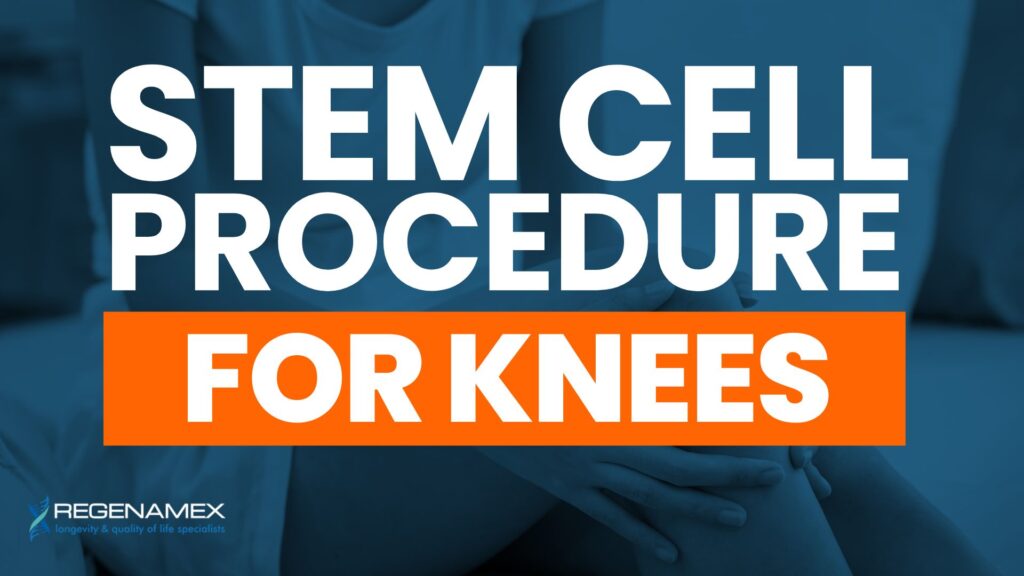
Stem Cell Procedure for Knees: What It Means and Why It Matters
A stem cell procedure for knees refers to delivering mesenchymal stem cells (MSCs) into or around the knee joint—usually via injection or guided implantation—to promote cartilage repair, reduce inflammation, and improve joint function. Rather than simply masking symptoms, these regenerative protocols aim to address underlying tissue degeneration and slow—or even partially reverse—the progression of osteoarthritis or cartilage injury. At Regenamex, we utilize ethically sourced MSCs derived from placental tissue and Wharton’s jelly, processed under COFEPRIS regulation, to support high viability, safety, and consistency.
This article delves into how a stem cell knee procedure is performed, its scientific basis, cost and value considerations, benefits and limitations, and how Regenamex positions itself as a top choice for patients seeking advanced joint regeneration. We also cover three related keywords knee stem cell therapy, mesenchymal stem cell cartilage repair, and regenerative knee treatment to optimize SEO and ensure comprehensive coverage.
Understanding Knee Degeneration & Why Regenerative Treatment Helps

Knee degeneration often develops gradually, as years of wear and tear compromise the smooth cartilage that cushions the joint. Whether from repetitive impact, obesity, aging, or sports injuries, cartilage loss exposes bone surfaces and disrupts natural biomechanics, leading to inflammation and pain. Over time, this inflammatory cycle worsens as the joint’s ability to self-repair diminishes. Traditional treatments such as corticosteroid injections, physical therapy, and NSAIDs only manage pain temporarily, without repairing underlying tissue damage. Even advanced options like hyaluronic acid injections or knee replacement surgery fail to address the biological mechanisms behind joint deterioration, leaving patients searching for safer, more durable solutions.
A knee stem cell therapy approach introduces a biologically active solution that targets these degenerative processes from within. Mesenchymal stem cells (MSCs), when injected into the knee joint, release powerful anti-inflammatory and regenerative factors that can slow cartilage loss, improve cushioning, and encourage the formation of new, healthy tissue. Research from both animal and human studies suggests that MSCs can stabilize the microenvironment of the knee, improve lubrication, and stimulate progenitor cells to repair early cartilage defects. For patients with mild to moderate osteoarthritis, this regenerative approach offers the possibility of delaying or even avoiding surgical intervention while restoring joint function naturally.
How Stem Cell Procedure for Knees Works
A stem cell procedure for knees begins with a thorough diagnostic phase to ensure precision and safety. Patients undergo MRI or X-ray imaging to evaluate cartilage thickness, joint space, and surrounding tissue health. Once a treatment plan is established, MSCs—either autologous (from the patient’s own body) or allogeneic (from ethical donor tissue)—are prepared under GMP-certified lab conditions. The stem cells are then tested for viability, purity, and sterility before being delivered to the treatment site. This meticulous preparation ensures that each patient receives a consistent and potent regenerative product.
When it comes to the procedure itself, there are several delivery strategies based on the extent of cartilage damage and patient goals. The most common technique is intra-articular injection, in which MSCs are precisely guided into the joint space using ultrasound or fluoroscopy to ensure accuracy. In more complex cases, MSCs may be combined with scaffolding materials to help them adhere to cartilage defects, enhancing their integration into the existing tissue. Regenamex often tailors these protocols to each patient’s condition, using guided injection methods and optional biological scaffolds to optimize cellular retention and repair.
Biological Mechanisms
The biological success of a regenerative knee treatment depends on how stem cells interact with the joint’s damaged environment. Once delivered, MSCs begin secreting a combination of growth factors and signaling molecules that regulate inflammation, repair tissue, and improve blood flow. These secretions downregulate inflammatory cytokines like TNF and IL-1β, reducing swelling and pain while stimulating anabolic pathways that rebuild the cartilage matrix. This modulation helps restore balance within the joint, shifting it from a degenerative state toward a healing one.
Beyond inflammation control, MSCs also drive mesenchymal stem cell cartilage repair through multiple synergistic actions. They stimulate collagen and proteoglycan synthesis, which thickens the cartilage layer, and help protect existing chondrocytes (cartilage cells) from apoptosis, or programmed cell death. MSCs also encourage angiogenesis—new blood vessel formation—to nourish the joint and bring oxygen and nutrients to repairing tissues. These combined effects make stem cell therapy a truly multifaceted solution that promotes both symptom relief and tissue regeneration in patients suffering from knee pain and stiffness.
Scientific Evidence & Clinical Trials
Clinical research supporting the stem cell procedure for knees has grown significantly over the past decade. Meta-analyses have found that MSC injections lead to measurable improvements in pain scores, stiffness, and physical function in patients with osteoarthritis, often outperforming conventional treatments like hyaluronic acid. Patients report less swelling and better movement within months of treatment. Pilot trials using bone marrow-derived or Wharton’s jelly-derived MSCs have demonstrated sustained benefits for over a year, with minimal adverse effects. In some studies, imaging confirmed increased cartilage thickness or improved joint space preservation, suggesting that real structural repair may occur in responsive patients.
Despite promising findings, experts urge cautious optimism. Many studies have small sample sizes or short follow-up periods, meaning that more research is needed to confirm long-term efficacy. Still, the overall trend is encouraging: most trials report consistent pain reduction, functional improvement, and high patient satisfaction rates. For patients who are not ready or eligible for joint replacement, these results highlight stem cell therapy as an effective, low-risk alternative that focuses on biological restoration rather than mechanical substitution. Regenamex integrates these findings into its protocols, ensuring patients receive evidence-based care backed by ongoing scientific advancements.
Cost Considerations & Pricing
The stem cell procedure for knees cost depends on several factors, including the type of stem cells used, laboratory processing standards, and the experience level of the clinic’s physicians. Autologous treatments—using a patient’s own cells—can be more labor-intensive and costly due to the extraction and expansion processes, while allogeneic MSCs from ethically sourced placental tissue provide a potent, ready-to-use option that reduces turnaround time.
Additional factors such as imaging guidance, use of PRP or exosome boosters, and follow-up appointments can also affect the overall price. Each of these components reflects a layer of safety, precision, and effectiveness in treatment.
In Mexico, regenerative care is far more affordable than in the United States or Canada, while maintaining world-class standards. Basic stem cell knee procedures range from $2,000 to $3,000 USD, with comprehensive all-inclusive packages (including follow-up and aftercare) reaching around $4,950 USD. By comparison, similar procedures in the U.S. often start at $5,000 and can exceed $15,000 depending on complexity. Regenamex provides transparent, bundled pricing that covers lab preparation, imaging, medical expertise, and aftercare—ensuring international patients can easily compare costs and understand what’s included without hidden fees.
Benefits & Risks

The benefits of a stem cell procedure for knees extend beyond pain relief—they include functional improvement, better quality of life, and potentially slowed disease progression. Patients commonly report enhanced flexibility, easier walking, and reduced dependency on medications. Because the therapy is minimally invasive, recovery time is short, and complications are rare. In contrast to joint replacement surgery, MSC therapy preserves the natural knee structure, allowing for a more organic restoration of movement. Early treatment with stem cells may also help delay or prevent the need for future surgery by stabilizing joint health.
Another key benefit is the natural mechanism of action. MSCs promote mesenchymal stem cell cartilage repair through anti-inflammatory regulation, tissue regeneration, and improved vascular support. By addressing the biological roots of degeneration, this therapy provides longer-lasting relief compared to cortisone or hyaluronic acid injections. Additionally, patients often experience reduced systemic inflammation, which can contribute to broader wellness benefits beyond the knee joint. Regenamex’s evidence-based approach ensures that these benefits are achieved under strict medical and regulatory oversight for optimal patient outcomes.
Limitations & Risks
While the results of knee stem cell therapy are encouraging, they are not guaranteed. Response rates vary depending on age, disease severity, and general health. Patients with severe, bone-on-bone degeneration may not achieve the same level of improvement as those with early cartilage wear. Some studies show that while pain and function improve, cartilage regeneration remains partial. Therefore, realistic expectations are crucial—MSC therapy is best viewed as a regenerative boost, not a cure-all.
Potential risks are relatively minor, especially when performed in regulated clinics like Regenamex. Temporary swelling, mild soreness, or stiffness at the injection site are common but short-lived. Unregulated clinics, however, may pose risks of contamination or cell misuse, underscoring the importance of choosing a COFEPRIS-certified provider. Regenamex mitigates these risks with GMP-grade labs, ethical cell sourcing, and comprehensive aftercare, ensuring that every patient receives safe, science-backed regenerative treatment.
What to Expect During a Regenamex Knee Stem Cell Procedure
Pre-Treatment Phase
Before the stem cell procedure for knees, Regenamex conducts a comprehensive pre-treatment evaluation. Patients undergo imaging tests such as MRI or X-ray, along with blood work to assess overall health and detect possible contraindications. This data helps design a customized treatment protocol, determining cell dosage and whether supportive therapies like PRP or exosomes should be added. The clinic’s team of regenerative medicine specialists reviews each case individually, ensuring that every patient’s plan aligns with their unique biological and anatomical profile.
Treatment Day & Recovery
On the treatment day, MSCs are precisely injected into the affected knee using image-guided technology for accuracy. The outpatient procedure is completed within a few hours, and most patients walk out of the clinic the same day. Recovery is rapid, typically involving only mild soreness that resolves within 48 hours. Within days, patients can resume light activity, and progressive improvement follows over the next few months as regeneration continues. Follow-up appointments help track healing through clinical assessment and imaging, ensuring long-term results are documented and maintained.
Regenamex’s Protocol & Value Proposition
Regenamex’s regenerative knee treatment program is founded on medical ethics, transparency, and scientific precision. Every stem cell used in our procedures is derived from ethically donated placental tissue and Wharton’s jelly, selected for their youthful potency and superior anti-inflammatory properties. The clinic’s COFEPRIS oversight guarantees adherence to GMP manufacturing standards, ensuring each cell batch meets the highest benchmarks for purity, viability, and sterility. These safeguards give patients confidence that their treatment is both safe and effective.
What truly sets Regenamex apart is its holistic, patient-focused care model. Beyond the knee stem cell therapy, patients receive integrated support through PRP and exosome boosters, hormone optimization when appropriate, and nutritional IV infusions to maximize regenerative capacity. International visitors benefit from the Fly & Buy program, which coordinates travel, accommodations, and post-procedure care. By combining affordability, global safety standards, and cutting-edge regenerative science, Regenamex stands as one of the leading destinations for patients seeking lasting relief from knee degeneration through advanced stem cell therapy.
FAQs: Stem Cell Procedure for Knees
A stem cell procedure for knees is a minimally invasive treatment that delivers mesenchymal stem cells (MSCs) directly into the damaged knee joint to help the body repair itself from within. These MSCs have powerful regenerative properties that can reduce inflammation, stimulate cartilage repair, and improve lubrication within the joint. Instead of relying on artificial implants or pain-masking medications, this therapy encourages the body to rebuild natural tissue and restore smoother, pain-free movement. At Regenamex, every MSC is ethically sourced from Wharton’s jelly and placental tissue, processed under COFEPRIS regulation, and tested for purity and viability before being administered to patients.
The knee stem cell therapy process at Regenamex begins with a comprehensive assessment that includes imaging (MRI or X-ray) to identify the exact location and extent of cartilage damage. On the day of treatment, MSCs are prepared in a GMP-certified lab to ensure sterility and potency. The cells are then injected directly into the joint space under ultrasound or fluoroscopic guidance, allowing precise placement around the areas most affected by inflammation or tissue wear. In some cases, microfracture or scaffolding techniques are used to create a more receptive environment for the cells to adhere and thrive.
Candidates for a stem cell procedure for knees are typically individuals experiencing mild to moderate osteoarthritis, cartilage thinning, or localized joint damage who wish to avoid invasive surgery. Ideal candidates still have some viable cartilage left, as the therapy works best when it can enhance existing tissue rather than replace it entirely. Patients who suffer from chronic pain, limited range of motion, or reduced knee stability due to degenerative conditions may also find significant benefit.
Clinical evidence supporting mesenchymal stem cell therapy for knees continues to grow. Multiple studies and meta-analyses have shown that patients receiving MSC injections report significant improvements in pain, stiffness, and physical function within 3 to 6 months of treatment. For instance, trials have demonstrated that MSCs can improve WOMAC and VAS scores—key measures of arthritis severity—by modulating inflammation and supporting cartilage regeneration. Patients often describe smoother movement, reduced swelling, and greater endurance during daily activities.
Like any medical treatment, a stem cell procedure for knees carries some potential risks, though they are minimal compared to surgery. The most common side effects include temporary swelling, mild discomfort at the injection site, or transient stiffness that resolves within a few days. Serious complications, such as infection or allergic reaction, are extremely rare—especially when performed in a regulated, sterile environment like Regenamex’s COFEPRIS-certified facility.
Recovery after a knee stem cell therapy session is typically quick and straightforward. Most patients resume light activities within 24 to 48 hours, though heavy exercise and high-impact sports should be avoided for at least two weeks. Mild soreness or swelling can occur as the body begins its healing response, but these effects are short-lived and can be managed with rest and gentle movement. Unlike surgery, which may require weeks or months of rehabilitation, stem cell therapy allows patients to return to daily routines almost immediately.

